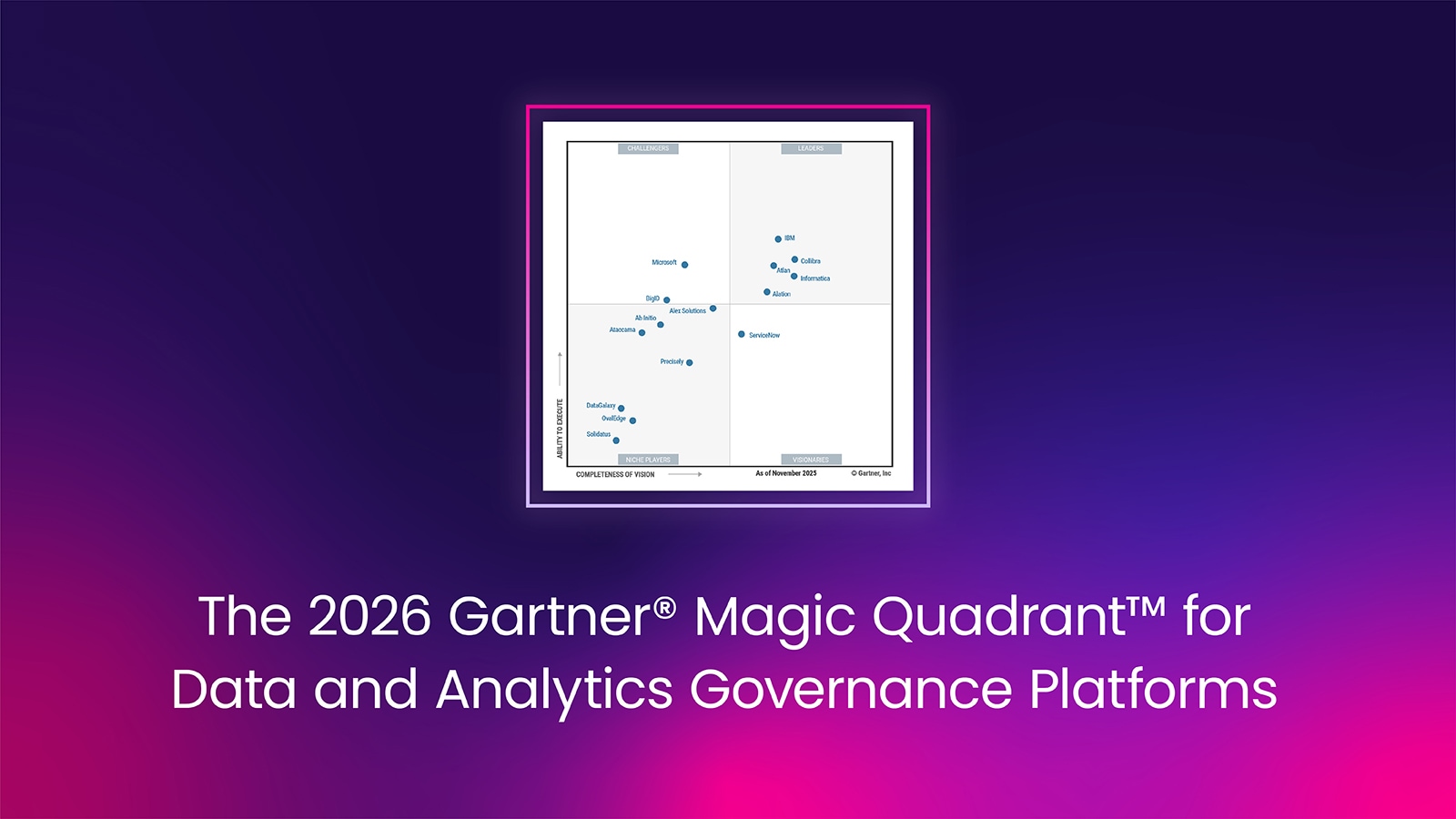Top 5 data management trends in 2024 + tips on how to maximize their value

While we all know AI will be in the spotlight again in 2024, many other data management trends are also emerging and require our attention.
This year, we’re delving into various trends beyond the usual AI narrative. We will examine the advancements in data management, including their origins and impact on the industry. Additionally, we will offer practical insights and tips for effectively handling these developments.
AI is the main focus, but data management has many exciting trends that are just as transformative and diverse. Let’s get started.
1. From hype to reality: Using GenAI to create business value

Some organizations have successfully incorporated GenAI into their daily operations, but many are still exploring how to use it effectively. In 2024, AI goes from being a trendy word to a useful tool for improving businesses.
The challenge for many businesses is shifting from an awe-inspired view of AI’s potential to a focused approach to using it strategically. Moving from the allure of AI as a trend to its practical integration into specific operational areas is the focus.
Companies are now asking more targeted questions: What unique problems can AI solve for us? How do we seamlessly integrate it into our existing processes? What skills and infrastructure do we need to leverage its full potential?
This shift towards GenAI is reshaping the data management landscape, as companies now prioritize aligning their data strategies with AI capabilities. The focus is on enhancing data quality, improving infrastructure, and developing the necessary skill sets to fully exploit AI’s potential. This evolution from mere enthusiasm to practical implementation of AI in data management signifies a mature approach to leveraging technology, transforming it from a futuristic concept into a key component of contemporary data strategy.
Tip
- Targeted problem-solving: Identify challenges where GenAI can be effectively applied in your organization.
- Infrastructure & skills upgrade: Ensure your data infrastructure supports GenAI and upskill your team for AI proficiency.
- Pilot and expand: Start with small-scale GenAI projects to test and refine, then gradually integrate into broader business processes for enhanced efficiency and impact.
These streamlined steps focus on effectively incorporating GenAI into your business, aligning it closely with your overall data management strategy in an organized and focused fashion.
2. Growing importance of data quality

Data quality importance has emerged from the shadows to claim its rightful place as the cornerstone of data management. This often-overlooked aspect is crucial for the success of trending topics like Generative AI, Data Democratization, Data Mesh, and many more. Without a solid foundation of quality data, all these trends risk faltering.
The spotlight on data quality will intensify this year for several pivotal reasons. With Generative AI taking center stage, businesses are recognizing that the output quality of AI is intrinsically linked to the data it processes. In essence, quality data forms the lifeblood of AI’s operational success. Furthermore, in an era of tightened budgets, the role of quality data in driving cost efficiency is becoming more apparent. It’s not just about reducing data clutter; it’s about optimizing operations and making smarter, more impactful decisions.
Simultaneously, the pursuit of enhanced customer satisfaction is pushing businesses to rely heavily on quality data. Personalized customer experiences, tailored services, and improved retention strategies are all driven by deep, insightful data. Quality data is a critical differentiator in understanding and meeting customer needs in this landscape.
2024 marks a year where quality data is not just a supporting player but a leading force in the narrative of data management, underpinning the success of various innovative trends.
Tip
- Prioritize key data assets: Focus on your most important data assets and identify areas for quality improvement.
- Implement monitoring solutions: Use data quality monitoring tools to continuously track and assess data quality.
- Resolve quality issues: Employ solutions like Ataccama ONE Data Quality Solution to address and correct identified data quality problems effectively.
- Scale up gradually: After improving quality in critical data areas, extend your focus to less essential systems, using automation to enhance data quality throughout your organization.
By following these steps, you can significantly elevate the quality of your data, ensuring it supports and enhances all aspects of your data management strategy.
3. Unified platforms overtaking Modern Data Stack

Remember the buzz around the modern data stack? It came with the promise of revolutionizing data management – making it sleek, cutting-edge, and, well, modern. But many companies can get discouraged once reality sets in. The quest for the perfect stack can lead to a chaotic mix of technologies, each with overlapping functionality, causing confusion and inefficiency.
Imagine juggling multiple tools with different interfaces – it’s like trying to speak several languages fluently at the same time – each with its own unique dialect. Integrating these tools is a full-time (and pricey) endeavor, leaving users scrambling between various platforms with unique design quirks to navigate.
Enter unified platforms. These are the ‘middle ground’ heroes in our story. Striking a balance between the old-school monolithic systems and the scattered single-purpose tools, unified platforms offer a comprehensive solution. They address a broad spectrum of data management needs while seamlessly integrating other essential technologies. This approach streamlines your data management stack, making it more cohesive and user-friendly.
Take, for example, solutions like Ataccama ONE. These platforms are about more than just managing data; they’re empowering businesses to use their data effectively without getting bogged down in the nitty-gritty of infrastructure management.
Tip
- Identify core data management challenges: Recognize the main use cases you focus on.
- Seek comprehensive solutions: Look for unified platforms that address your primary challenges and offer a broad range of functionalities.
- Aim for cohesive integration: Choose a solution that integrates well with your existing systems, enhancing overall data management efficiency and user experience.
Following these steps will help you transition to a more unified, efficient, and effective data management system, addressing the complexities of modern data needs.
4. AI Governance

AI Governance is the process of establishing and enforcing rules, policies, and ethical guidelines for developing and using AI technologies. It ensures that AI systems operate fairly, responsibly, and transparently within an organization.
More than just managing AI applications, it’s about aligning these applications with data policies and the ethical standards that form the core of corporate governance. This intersection is critical, as AI and data governance collectively address key challenges such as ethical usage, bias prevention, and privacy protection, all of which are integral to corporate governance.

Effective AI Governance in 2024 involves weaving AI policies into the fabric of data governance and ensuring they align with corporate governance objectives. This integrated approach creates a comprehensive governance framework. AI won’t be an isolated element but part of the broader corporate strategy, contributing to responsible and effective technology use across the organization.
As AI technologies advance, the fusion of AI, data, and corporate governance strategies becomes increasingly essential, forming a multi-layered governance approach vital for ethical and efficient organizational operation.
Tip
- Communicate the ‘why’: Begin by clearly articulating the importance of AI governance to your entire company. Emphasize why it’s essential, focusing on its role in guiding responsible AI use and aligning with ethical standards.
- Establish an AI council: Form a dedicated AI Council group within your company. This team will spearhead the AI governance initiative, from defining guidelines to overseeing its implementation and education efforts.
- Initiate immediate training: Recognize that some employees might already use AI tools. Address this by rolling out basic training sessions as soon as possible. These should cover fundamental aspects of AI governance, ensuring immediate understanding and compliance.
By focusing first on the rationale behind AI governance, forming a dedicated group to lead the effort, and initiating prompt training, organizations can lay a strong foundation for responsible AI usage that aligns with their core values and operational goals.
5. Automation as the only way forward

In 2024, the mantra for data management is clear: do more with the same resources you have today. With budgets remaining tight and the demands on data teams growing, the focus is intensifying on cost efficiency and lean operations. Companies face the dual challenge of embracing new initiatives like AI governance and enhancing customer retention, all without expecting significant increases in their data management budgets. This reality is steering organizations towards one inevitable solution: automation.
The rationale is straightforward: automation tools can handle repetitive, time-consuming tasks, freeing data professionals to focus on more strategic, high-value activities. By automating data governance and quality aspects, companies can ensure consistent application of policies, reduce the risk of human error, and maintain high data standards with less manual intervention.
This trend toward automation is not just about cutting costs or saving time; it’s about enhancing the overall effectiveness of data management practices. As companies navigate the complexities of modern data landscapes, including compliance with evolving regulations and leveraging AI technologies, the role of automation in data management is proving to be more crucial than ever. It’s a strategic pivot enabling organizations to stay agile, responsive, and competitive in a rapidly evolving business environment.
Tip
- Identify repetitive tasks: Pinpoint your data management workflow’s most time-consuming, repetitive tasks.
- Leverage existing tools: Assess if your current data management stack can automate these tasks. If not, explore external automation solutions.
- Adopt an automation-first approach: In new use cases, prioritize finding automated solutions over expanding the team, fostering a culture of efficiency and innovation.
These steps streamline your data management processes, maximizing productivity while minimizing costs.
Conclusion
Each of these five trends is significant and demand attention, but tackling them all simultaneously isn’t practical. The key is to identify which trend aligns most closely with your organization’s current priorities and potential for growth.
Focus on what truly matters for your company now – improving data quality, leveraging AI, or advancing automation – and invest your efforts there. It’s about doing fewer things but doing them exceptionally well, ensuring meaningful progress and tangible results. Once you feel confident, you’ll know you’re on the right track.
As you embark on this journey, remember that each step presents unique opportunities and the promise of transformation. The world of data management is rich with potential, ready to be explored and harnessed. Stay motivated and forward-looking as your decisions and actions shape your organization’s future.
Onboard a data management solution at the frontline of all these trends and innovations: Ataccama ONE. Visit the platform page and schedule a call today.
David Kolinek
David is our VP of Product Marketing at Ataccama, with 8 years of experience in the Data Management space. He previously served as VP of Product for the Data Governance Suite and held roles at Socialbakers (now Emplifi). He holds a Master’s in Information Systems and Technologies from the Prague University of Economics and Business.








